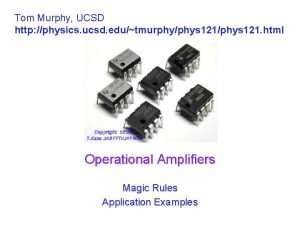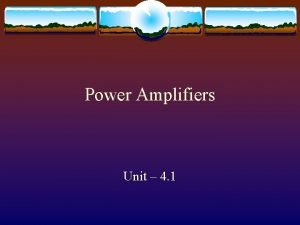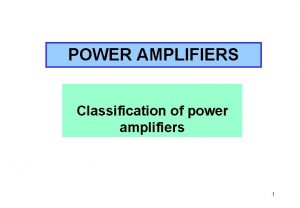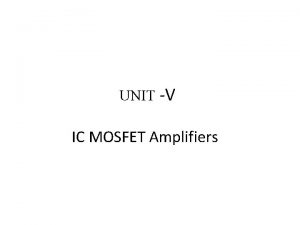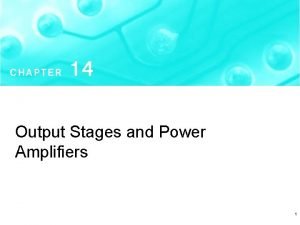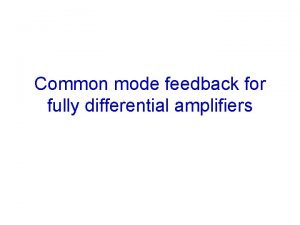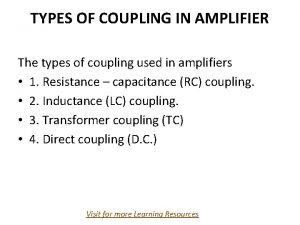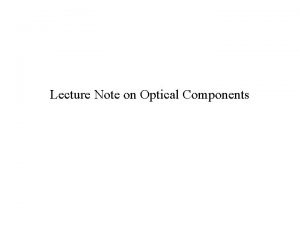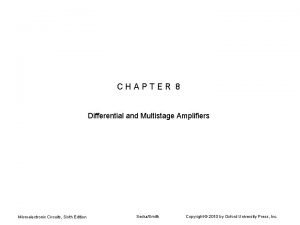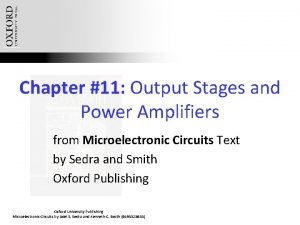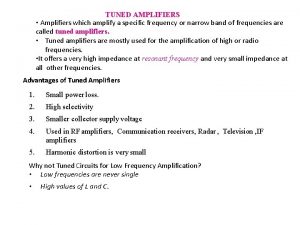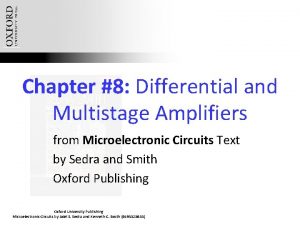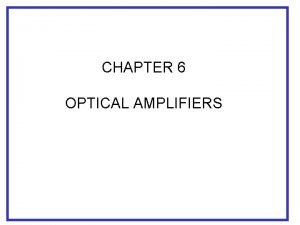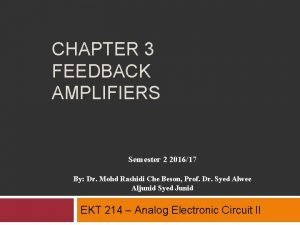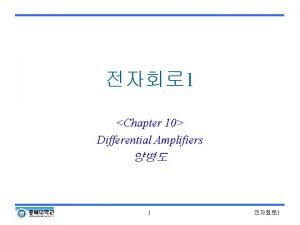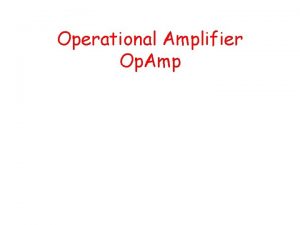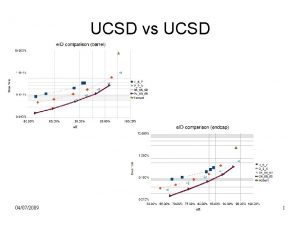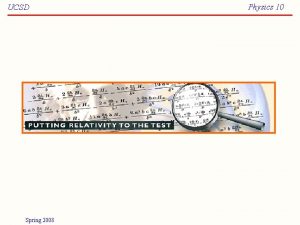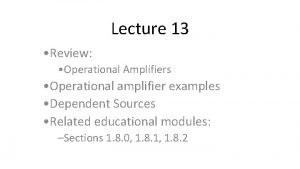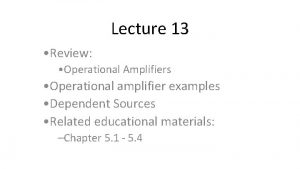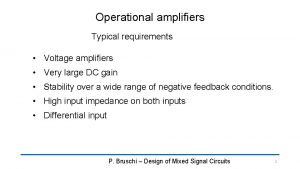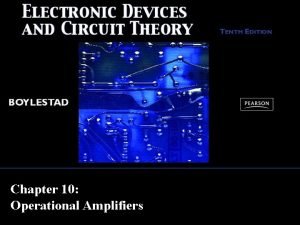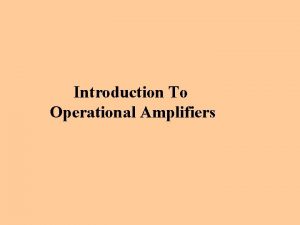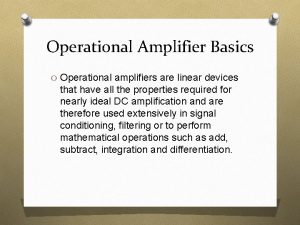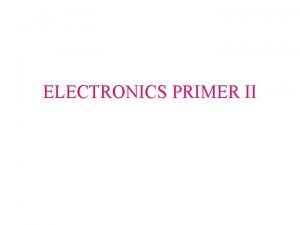Operational Amplifiers Magic Rules Application Examples UCSD Physics




















- Slides: 20

Operational Amplifiers Magic Rules Application Examples

UCSD: Physics 121; 2012 Op-Amp Introduction • Op-amps (amplifiers/buffers in general) are drawn as a triangle in a circuit schematic • There are two inputs – inverting and non-inverting • And one output • Also power connections (note no explicit ground) divot on pin-1 end V+ inverting input non-inverting input 2 3 7 6 + output 4 V Winter 2012 2

UCSD: Physics 121; 2012 The ideal op-amp • Infinite voltage gain – a voltage difference at the two inputs is magnified infinitely – in truth, something like 200, 000 – means difference between + terminal and terminal is amplified by 200, 000! • Infinite input impedance – no current flows into inputs – in truth, about 1012 for FET input op-amps • Zero output impedance – rock-solid independent of load – roughly true up to current maximum (usually 5– 25 m. A) • Infinitely fast (infinite bandwidth) – in truth, limited to few MHz range – slew rate limited to 0. 5– 20 V/ s Winter 2012 3

UCSD: Physics 121; 2012 Op-amp without feedback • The internal op-amp formula is: Vout = gain (V+ V ) • So if V+ is greater than V , the output goes positive • If V is greater than V+, the output goes negative V V+ + Vout • A gain of 200, 000 makes this device (as illustrated here) practically useless Winter 2012 4

UCSD: Physics 121; 2012 Infinite Gain in negative feedback • Infinite gain would be useless except in the selfregulated negative feedback regime – negative feedback seems bad, and positive good—but in electronics positive feedback means runaway or oscillation, and negative feedback leads to stability • • • Imagine hooking the output to the inverting terminal: If the output is less than Vin, it shoots positive If the output is greater than Vin, it shoots negative – result is that output quickly forces itself to be exactly Vin Winter 2012 negative feedback loop + 5

UCSD: Physics 121; 2012 Even under load • Even if we load the output (which as pictured wants to drag the output to ground)… – the op-amp will do everything it can within its current limitations to drive the output until the inverting input reaches Vin – negative feedback makes it self-correcting – in this case, the op-amp drives (or pulls, if Vin is negative) a current through the load until the output equals Vin – so what we have here is a buffer: can apply Vin to a load without burdening the source of Vin with any current! Vin Winter 2012 + Important note: op-amp output terminal sources/sinks current at will: not like inputs that have no current flow 6

UCSD: Physics 121; 2012 Positive feedback pathology • In the configuration below, if the + input is even a smidge higher than Vin, the output goes way positive • This makes the + terminal even more positive than Vin, making the situation worse • This system will immediately “rail” at the supply voltage – could rail either direction, depending on initial offset Vin + Winter 2012 positive feedback: BAD 7

UCSD: Physics 121; 2012 Op-Amp “Golden Rules” • When an op-amp is configured in any negativefeedback arrangement, it will obey the following two rules: – The inputs to the op-amp draw or source no current (true whether negative feedback or not) – The op-amp output will do whatever it can (within its limitations) to make the voltage difference between the two inputs zero Winter 2012 8

UCSD: Physics 121; 2012 Inverting amplifier example R 2 R 1 Vin + Vout • Applying the rules: terminal at “virtual ground” – so current through R 1 is If = Vin/R 1 • Current does not flow into op-amp (one of our rules) – so the current through R 1 must go through R 2 – voltage drop across R 2 is then If. R 2 = Vin (R 2/R 1) • So Vout = 0 Vin (R 2/R 1) = Vin (R 2/R 1) • Thus we amplify Vin by factor R 2/R 1 – negative sign earns title “inverting” amplifier • Current is drawn into op-amp output terminal Winter 2012 9

UCSD: Physics 121; 2012 Non-inverting Amplifier R 2 R 1 Vin + Vout • Now neg. terminal held at Vin – so current through R 1 is If = Vin/R 1 (to left, into ground) • This current cannot come from op-amp input – – – so comes through R 2 (delivered from op-amp output) voltage drop across R 2 is If. R 2 = Vin (R 2/R 1) so that output is higher than neg. input terminal by Vin (R 2/R 1) Vout = Vin + Vin (R 2/R 1) = Vin (1 + R 2/R 1) thus gain is (1 + R 2/R 1), and is positive • Current is sourced from op-amp output in this example Winter 2012 10

UCSD: Physics 121; 2012 Summing Amplifier Rf R 1 V 1 R 2 V 2 + Vout • Much like the inverting amplifier, but with two input voltages – inverting input still held at virtual ground – I 1 and I 2 are added together to run through Rf – so we get the (inverted) sum: Vout = Rf (V 1/R 1 + V 2/R 2) • if R 2 = R 1, we get a sum proportional to (V 1 + V 2) • Can have any number of summing inputs – we’ll make our D/A converter this way Winter 2012 11

UCSD: Physics 121; 2012 Differencing Amplifier R 2 R 1 V + V+ Vout R 1 R 2 • The non-inverting input is a simple voltage divider: – Vnode = V+R 2/(R 1 + R 2) • So If = (V Vnode)/R 1 – Vout = Vnode If. R 2 = V+(1 + R 2/R 1)(R 2/(R 1 + R 2)) V (R 2/R 1) – so Vout = (R 2/R 1)(V V ) – therefore we difference V and V Winter 2012 12

UCSD: Physics 121; 2012 Differentiator (high-pass) R C Vin + Vout • For a capacitor, Q = CV, so Icap = d. Q/dt = C·d. V/dt – Thus Vout = Icap. R = RC·d. V/dt • So we have a differentiator, or high-pass filter – if signal is V 0 sin t, Vout = V 0 RC cos t – the -dependence means higher frequencies amplified more Winter 2012 13

UCSD: Physics 121; 2012 Low-pass filter (integrator) C R Vin + Vout • If = Vin/R, so C·d. Vcap/dt = Vin/R – and since left side of capacitor is at virtual ground: d. Vout/dt = Vin/RC – so – and therefore we have an integrator (low pass) Winter 2012 14

UCSD: Physics 121; 2012 RTD Readout Scheme Winter 2012 15

UCSD: Physics 121; 2012 Notes on RTD readout • RTD has resistance R = 1000 + 3. 85 T( C) • Goal: put 1. 00 m. A across RTD and present output voltage proportional to temperature: Vout = V 0 + T • First stage: – put precision 10. 00 V reference across precision 10 k resistor to make 1. 00 m. A, sending across RTD – output is 1 V at 0 C; 1. 385 V at 100 C • Second stage: – resistor network produces 0. 25 m. A of source through R 9 – R 6 slurps 0. 25 m. A when stage 1 output is 1 V • so no current through feedback output is zero volts – At 100 C, R 6 slurps 0. 346 m. A, leaving net 0. 096 that must come through feedback – If R 7 + R 8 = 10389 ohms, output is 1. 0 V at 100 C • Tuning resistors R 11, R 7 allows control over offset and gain, respectively: this config set up for Vout = 0. 01 T Winter 2012 16

UCSD: Physics 121; 2012 Hiding Distortion • Consider the “push-pull” transistor arrangement to the right – an npn transistor (top) and a pnp (bot) – wimpy input can drive big load (speaker? ) – base-emitter voltage differs by 0. 6 V in each transistor (emitter has arrow) – input has to be higher than ~0. 6 V for the npn to become active – input has to be lower than 0. 6 V for the pnp to be active • There is a no-man’s land in between where neither transistor conducts, so one would get “crossover distortion” V+ out in V crossover distortion – output is zero while input signal is between 0. 6 and 0. 6 V Winter 2012 17

UCSD: Physics 121; 2012 Stick it in the feedback loop! V+ Vin out + V input and output now the same • By sticking the push-pull into an op-amp’s feedback loop, we guarantee that the output faithfully follows the input! – after all, the golden rule demands that + input = input • Op-amp jerks up to 0. 6 and down to 0. 6 at the crossover – it’s almost magic: it figures out the vagaries/nonlinearities of the thing in the loop • Now get advantages of push-pull drive capability, without the mess Winter 2012 18

UCSD: Physics 121; 2012 Dogs in the Feedback Vin “there is no dog” + inverse dog • The op-amp is obligated to contrive the inverse dog so that the ultimate output may be as tidy as the input. • Lesson: you can hide nasty nonlinearities in the feedback loop and the op-amp will “do the right thing” We owe thanks to Hayes & Horowitz, p. 173 of the student manual companion to the Art of Electronics for this priceless metaphor. Winter 2012 19

UCSD: Physics 121; 2012 Reading • Read 6. 4. 2, 6. 4. 3 • Pay special attention to Figure 6. 66 (6. 59 in 3 rd ed. ) Winter 2012 20
 Operational amplifiers
Operational amplifiers Physics courses ucsd
Physics courses ucsd Ucsd physics courses
Ucsd physics courses Ucsd physics
Ucsd physics Ucsd physics courses
Ucsd physics courses Classification of power amplifier
Classification of power amplifier Classification of power amplifiers
Classification of power amplifiers Pmos cs amplifier
Pmos cs amplifier Special-purpose op-amp circuits
Special-purpose op-amp circuits Vbe multiplier class ab
Vbe multiplier class ab Cmfb fully-differential amplifiers
Cmfb fully-differential amplifiers Types of coupling in amplifier
Types of coupling in amplifier Optical amplifiers lecture notes
Optical amplifiers lecture notes Differential and multistage amplifiers
Differential and multistage amplifiers Class ab output stage
Class ab output stage Advantages of tuned amplifier
Advantages of tuned amplifier Differential and multistage amplifiers
Differential and multistage amplifiers In-line optical dwdm amplifiers
In-line optical dwdm amplifiers Shunt series configuration
Shunt series configuration Differential pair with active load
Differential pair with active load Applications of amplifiers
Applications of amplifiers



